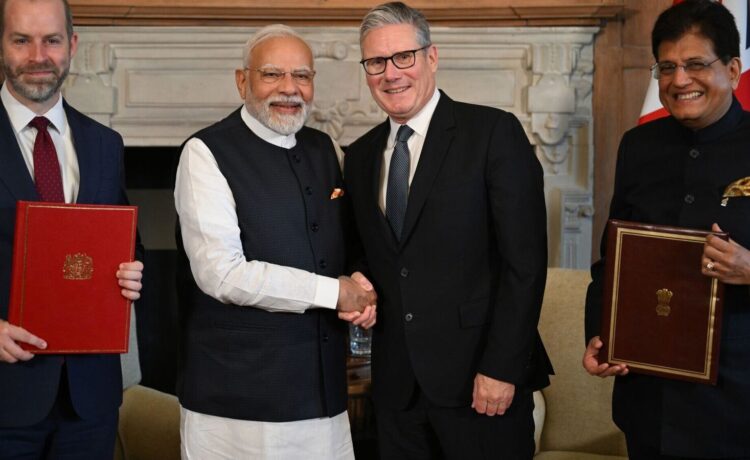New Delhi: India and the United Kingdom on Thursday signed a landmark free trade agreement, ending years of protracted negotiations and marking a new phase in their economic partnership. The deal will give a major push to bilateral trade and investment, offering greater market access across key sectors.
This is the most comprehensive FTA signed by the UK in the Indo-Pacific region post-Brexit, and adds to India’s growing portfolio of bilateral trade agreements, including those with Australia and the UAE.
The agreement, aimed at boosting goods and services trade between the two countries, was signed by commerce minister Piyush Goyal and his British counterpart Jonathan Reynolds in the presence of Prime Minister Narendra Modi and British prime minister Keir Starmer.
The India-UK FTA promises to unlock major economic gains for India by eliminating tariffs on 99% of Indian exports, covering nearly 100% of the trade value.
Indian businesses will benefit from zero-duty access to the UK, including for exports of textiles, footwear, carpets, cars, and marine products, which currently face tariffs of 4-16%. The UK will see tariff reductions in India on luxury items such as Scotch whisky and premium cars.
“Indian textiles, footwear, gems and jewellery, seafood, and engineering goods will gain better market access in the UK. New opportunities will also open up for India’s agricultural produce and processed food industry in the British market,” Modi said, announcing the deal.
“This agreement will be especially beneficial for India’s youth, farmers, fishermen, and the MSME sector,” Modi added. “At the same time, products made in the UK—such as medical devices and aerospace parts—will become more accessible and affordable for Indian consumers and industry.”
The India-UK FTA does not include the Carbon Border Adjustment Mechanism (CBAM) —the so-called carbon tax—at this stage, but both sides said it will be taken up for discussions later.
Modi also said India and the UK would discuss a ‘Vision 2035’ programme as part of a comprehensive strategic partnership between the two countries over the next decade.
“This will serve as a roadmap for a strong, trusted, and ambitious partnership across technology, defence, climate, education, and people-to-people connections,” he said.
Modi also thanked Starmer and the British government for their strong condemnation of the terrorist attack in Pahalgam. “We are united in our view that there can be no place for double standards in the fight against terrorism,” he said.
A $120 billion target
India and the UK had concluded negotiations for the free trade agreement on 6 May after more than two years of talks.
The FTA—formally known as the Comprehensive Economic and Trade Agreement—seeks to increase bilateral trade to $120 billion by 2030 by eliminating or significantly reducing customs duties on a wide range of products.
India’s merchandise exports to the UK rose 12.6% to $14.5 billion in 2024-25, while imports grew marginally by 2.3% to $8.6 billion. Total bilateral trade stood at $21.34 billion in 2023-24, up from $20.36 billion in the previous year.
The FTA—comprising 27 chapters, including on services, innovation, government procurement, intellectual property rights, and anti-corruption—will come into effect after it is ratified by the UK Parliament, which may take another six months.
It also marks India’s first major bilateral trade agreement with a developed Western economy since the Modi government accelerated its FTA agenda, part of a wider strategy to diversify export markets and attract investments.
Separately, India and the UK have concluded negotiations on a social security agreement—called the Double Contribution Convention—that will allow Indian professionals working in Britain on short-term assignments to avoid paying into both countries’ social security systems.
Dr. Anish Shah, group chief executive and managing director, Mahindra Group, said the India-UK FTA is not just a win for trade, but a blueprint for a modern, values-led partnership that puts innovation, sustainability, and inclusive growth at the heart of global collaboration.
Sudhir Sekhri, chairman of the Apparel Export Promotion Council, said the India-UK FTA will “usher in a new era of garment trade” with the UK. “This agreement will enhance market access, spur investment and job creation in the garment sector, besides creating new opportunities for businesses and consumers on both sides,” he said.
The UK is the world’s fifth largest garment importer. The country imported garments worth $19.7 billion in 2024. That year, India exported $1.2 billion worth of garments to the UK, emerging as one among the country’s top four suppliers.
India-UK FTA negotiations—a timeline
The India-UK FTA was finalised after an extensive series of 14 negotiation rounds spanning over three years.
January 2022: Talks for the India-UK FTA begin, seven months after prime ministers Narendra Modi and Boris Johnson announced the Enhanced Trade Partnership between the two countries. The first round was held virtually in January 2022, followed by alternating meetings in London and New Delhi through the year.
2023 and 2024: Despite initial optimism to conclude the deal by Diwali 2022, political developments in the UK—most notably the resignation of Prime Minister Liz Truss—led to delays. Negotiations continued steadily through 2023 and 2024, with both sides engaging in detailed discussions to resolve key issues related to tariffs, services, investment, and market access.
January-March 2024: Negotiations held during this period helped bridge several remaining gaps in the India-UK free trade agreement. This round—the 14th and final—continued through a change in leadership in the UK, with Keir Starmer assuming office as UK prime minister on 5 July 2024.
February 2025: After a wait of over seven months, the UK announced resumption of FTA talks.
6 May: India and the UK formally announced the conclusion of negotiations.
24 July: India and the UK formally signed the landmark free trade agreement.





